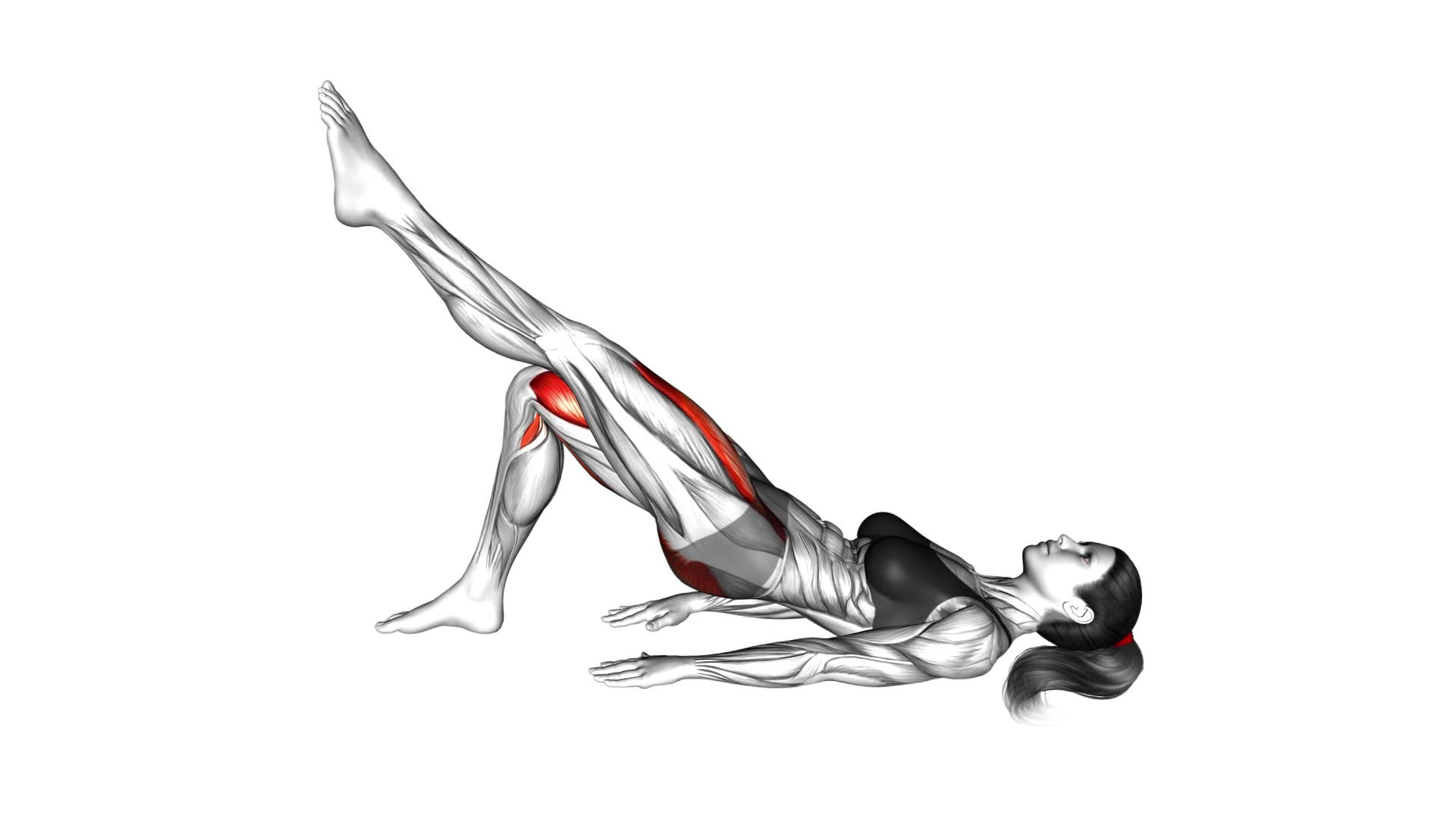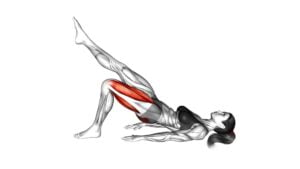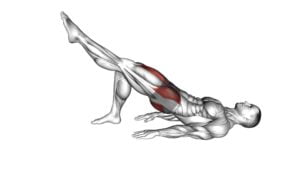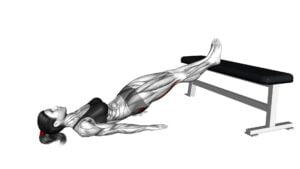Single Straight Leg Glute Bridge Hold (female) – Video Exercise Guide & Tips

Are you looking for an effective glute exercise that targets your muscles and increases your strength? Look no further than the Single Straight Leg Glute Bridge Hold.
Watch This Exercise Video
This exercise, specifically designed for females, is a great way to engage your glutes and improve your overall fitness.
In this video exercise guide, we'll show you the proper form and technique, variations for increased difficulty, common mistakes to avoid, and tips for maximizing the effectiveness of the glute bridge hold.
Get ready to strengthen and tone your glutes like never before!
Key Takeaways
- The Single Straight Leg Glute Bridge Hold is a beneficial exercise for increasing glute activation, improving hip stability, and strengthening the glute muscles.
- Proper form and technique for the exercise include maintaining proper spinal alignment, engaging the core and glutes, and avoiding common errors such as lifting the hips too high or allowing the knees to collapse inward.
- Variations and progressions can be added to increase the difficulty of the exercise, such as using resistance bands or weights, performing the exercise on an unstable surface, or incorporating pulses or holds at the top of the bridge position.
- To maximize the effectiveness of the Glute Bridge Hold, it is important to engage the glutes, maintain proper form, gradually increase difficulty, listen to your body, and include the exercise in lower body or glute-focused workouts.
Benefits of the Single Straight Leg Glute Bridge Hold
Discover the numerous benefits you can achieve by incorporating the Single Straight Leg Glute Bridge Hold into your fitness routine. This exercise is highly effective in increasing glute activation and improving hip stability. By performing the Single Straight Leg Glute Bridge Hold, you can specifically target your gluteus maximus, medius, and minimus muscles, resulting in a more sculpted and toned posterior.
This exercise also helps to strengthen your hip muscles, which can improve overall hip stability and prevent injuries.
Increased glute activation is one of the key benefits of this exercise. By lifting your hips off the ground and holding the position with one leg extended straight, you're engaging your glute muscles to support your body weight. This not only helps to tone and shape your glutes, but it also enhances their strength and functionality.
Furthermore, the Single Straight Leg Glute Bridge Hold improves hip stability. As you perform this exercise, you're challenging the muscles around your hips to maintain balance and control. This can greatly benefit athletes or individuals who participate in activities that require stability, such as running, jumping, or playing sports.
To ensure you get the most out of this exercise, it's important to maintain proper form and technique. By following the correct form, you can maximize the benefits and minimize the risk of injury.
Proper Form and Technique for the Exercise
To perform the Single Straight Leg Glute Bridge Hold with proper form and technique, follow these steps:
- Lie on your back with your knees bent and feet flat on the ground.
- Extend one leg straight, keeping it in line with your body.
- Place your arms by your sides, palms facing down.
- Engage your core and squeeze your glutes as you lift your hips off the ground, creating a straight line from your shoulders to your knees.
- Ensure that your weight is evenly distributed between your shoulders and feet, and avoid letting your knees cave in or flare out.
- Hold this position for the desired amount of time, focusing on maintaining proper form.
Now, let's address some common errors to watch out for:
- Lifting your hips too high, which can put excessive strain on your lower back. Remember to lift your hips to a point where your body forms a straight line, but avoid hyperextension.
- Not fully engaging your glutes. Make sure to squeeze your glutes throughout the exercise to maximize activation.
- Allowing your knee to drop inward or outward. Keep your knee in line with your hip and ankle to maintain alignment and prevent strain on your joints.
If you find the Single Straight Leg Glute Bridge Hold challenging or want to switch things up, there are alternatives you can try:
- Instead of extending one leg straight, you can perform the exercise with both feet on the ground. This modification reduces the difficulty while still targeting the glutes.
- Using a resistance band around your thighs can provide added resistance and increase the intensity of the exercise.
Experiment with different variations to find what works best for you and your fitness level.
Variations and Progressions for Increased Difficulty
To increase the difficulty of the Single Straight Leg Glute Bridge Hold, you can incorporate variations and progressions into your exercise routine. By modifying the exercise, you can target different muscles and challenge your body in new ways. Here are some advanced modifications and muscle activation techniques to take your glute bridge hold to the next level:
- Single Leg Glute Bridge Hold with Resistance Band: Place a resistance band around your thighs, just above your knees, and perform the exercise with one leg lifted. The added resistance from the band will engage your glutes and hip muscles even more.
- Single Leg Glute Bridge Hold with Weight: Hold a dumbbell or kettlebell on your hips while performing the exercise. The added weight will increase the intensity and challenge your glutes to work harder.
- Single Leg Glute Bridge Hold with Stability Ball: Place a stability ball between your feet and lift one leg off the ground. The instability of the ball will require greater activation of your core and glutes to maintain balance.
- Single Leg Glute Bridge Hold with Leg Extension: While holding the bridge position, extend the lifted leg straight out in front of you. This variation adds an extra challenge to your glutes and requires greater stability and control.
Incorporating these advanced modifications and muscle activation techniques into your Single Straight Leg Glute Bridge Hold routine will help you progress and continue challenging your glute muscles. Remember to always maintain proper form and listen to your body to avoid injury.
Common Mistakes to Avoid During the Exercise
To effectively perform the Single Straight Leg Glute Bridge Hold and prevent injury, it's important to be aware of common mistakes to avoid while doing the exercise.
One common mistake is lifting the hips too high. While it might feel like you're getting a better glute workout, lifting the hips too high can put excessive strain on the lower back. To avoid this, focus on maintaining a straight line from your knees to your shoulders throughout the exercise.
Another mistake isn't engaging the core. Your core muscles play a crucial role in stabilizing your body during the glute bridge hold. To engage your core, imagine pulling your belly button towards your spine and contracting your abdominal muscles.
Additionally, it's important to avoid letting your knees collapse inward. This can put unnecessary stress on the knees and lead to discomfort or injury. Instead, focus on keeping your knees in line with your hips and ankles throughout the exercise.
Tips for Maximizing the Effectiveness of the Glute Bridge Hold
To maximize the effectiveness of the Glute Bridge Hold, focus on proper form and technique. Here are some tips to help you get the most out of this exercise:
- Engage your glutes: Squeeze your glutes as you lift your hips off the ground, and focus on using your glute muscles to drive the movement. This will help increase glute activation and make the exercise more effective.
- Maintain a neutral spine: Keep your spine in a neutral position throughout the movement. Avoid arching your back or tucking your pelvis too much, as this can put unnecessary strain on your lower back. Engaging your core muscles can help you maintain proper spinal alignment.
- Control the movement: Slowly lower your hips back down to the ground, rather than simply dropping them. This will engage your muscles for a longer duration, increasing the intensity of the exercise.
- Incorporate the Glute Bridge Hold into your workout routine: You can perform this exercise as part of a lower body or glute-focused workout. Start with a few sets of 10-15 seconds and gradually increase the duration as your strength improves. You can also add resistance by placing a weight or resistance band across your hips.
Frequently Asked Questions
How Many Reps and Sets Should I Do for the Single Straight Leg Glute Bridge Hold?
To determine how many reps and sets you should do for the single straight leg glute bridge hold, consider your fitness goals and current level of strength.
Start with 2-3 sets of 8-12 reps, focusing on maintaining proper form and engaging your glute muscles throughout each hold.
Gradually increase the number of reps and sets as you become more comfortable and stronger.
Remember to consult with a fitness professional for personalized guidance and to explore variations of the exercise for added benefits.
Can Men Also Benefit From Doing the Single Straight Leg Glute Bridge Hold?
Yes, men can definitely benefit from doing the single straight leg glute bridge hold! This exercise helps to strengthen the glutes, hamstrings, and lower back, which are important for overall lower body strength and stability.
Men can modify the exercise by adjusting the intensity or adding weights to challenge themselves even more. By incorporating this exercise into their workout routine, men can improve their athletic performance, prevent injuries, and enhance their overall physique.
Is It Normal to Feel Discomfort in the Lower Back While Performing the Exercise?
Feeling discomfort in your lower back during the single straight leg glute bridge hold isn't normal and may indicate improper form or technique.
To perform the exercise correctly, lie on your back with one leg straight and the other bent. Lift your hips off the ground, keeping your core engaged and avoiding arching your lower back.
Common mistakes to avoid include using your lower back to lift your hips and not maintaining a straight line from your shoulders to your knees.
Can the Single Straight Leg Glute Bridge Hold Help Improve My Posture?
Improving your posture is one of the benefits of incorporating glute exercises into your workout routine.
The single straight leg glute bridge hold is a great exercise for targeting your glutes and strengthening your core, which can help improve your posture.
To properly perform this exercise, lie on your back with one leg straight and the other bent.
Lift your hips off the ground, squeezing your glutes, and hold for a few seconds before lowering back down.
Is It Necessary to Use a Resistance Band or Any Additional Equipment for This Exercise?
No, it isn't necessary to use a resistance band or any additional equipment for this exercise. However, using a resistance band can provide added resistance and make the exercise more challenging.
If you don't have a resistance band, there are alternative ways to perform the single straight leg glute bridge hold. For beginners, you can start by performing the exercise with both feet on the ground and gradually progress to lifting one leg at a time.
Conclusion
In conclusion, the single straight leg glute bridge hold is an effective exercise for targeting and strengthening the glute muscles.
By maintaining proper form and technique, you can maximize the benefits of this exercise.
Additionally, incorporating variations and progressions can increase the difficulty and challenge your muscles even further.
By avoiding common mistakes and following the provided tips, you can ensure the effectiveness of the glute bridge hold in your workout routine.

Author
Years ago, the spark of my life’s passion ignited in my mind the moment I stepped into the local gym for the first time. The inaugural bead of perspiration, the initial endeavor, the very first surge of endorphins, and a sense of pride that washed over me post-workout marked the beginning of my deep-seated interest in strength sports, fitness, and sports nutrition. This very curiosity blossomed rapidly into a profound fascination, propelling me to earn a Master’s degree in Physical Education from the Academy of Physical Education in Krakow, followed by a Sports Manager diploma from the Jagiellonian University. My journey of growth led me to gain more specialized qualifications, such as being a certified personal trainer with a focus on sports dietetics, a lifeguard, and an instructor for wellness and corrective gymnastics. Theoretical knowledge paired seamlessly with practical experience, reinforcing my belief that the transformation of individuals under my guidance was also a reflection of my personal growth. This belief holds true even today. Each day, I strive to push the boundaries and explore new realms. These realms gently elevate me to greater heights. The unique combination of passion for my field and the continuous quest for growth fuels my drive to break new ground.







